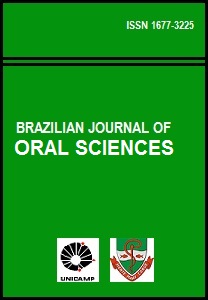Abstract
Aim: To evaluate the bond strength of brackets bonded after different surface treatments on two dental ceramics. Methods: One hundred and twenty discs (5 mm thick and 7 mm diameter) of two ceramic types were made and randomly divided in 8 groups. Groups 1, 3, 5, and 7 used Eris ceramic and groups 2, 4, 6, and 8 used d.Sign ceramic. The ceramic surfaces were treated with 10% hydrofluoric acid (G1 and G2), 10% hydrofluoric acid + silane (G3 and G4), aluminum oxide blasting + 35% phosphoric acid + silane (G5 and G6), CoJet blasting + 35% phosphoric acid + silane (G7 and G8). Metallic brackets were cemented with Concise cement. Mechanical test was performed in a universal testing machine until failure. Results: The average values (MPa) obtained (G1 - 7.30; G2 - 6.12; G3 - 17.49; G4 - 19.54; G5 - 18.80; G6 - 21.93; G7 - 6.81 e G8 - 9.77) were submitted to ANOVA and Tukey test (p<0.05). The fracture patterns were analyzed in stereoscopic microscope (25´X) and representative samples of each group were analyzed in SEM. Conclusions: It was possible to conclude that use of silane after hydrofluoric acid increased the bond strength values.
This work is licensed under a Creative Commons Attribution 4.0 International License.
Copyright (c) 2015 Naudy Brodbeck May, Élito Araújo, Luiz Clovis Cardoso Vieira
Downloads
Download data is not yet available.

